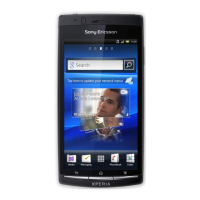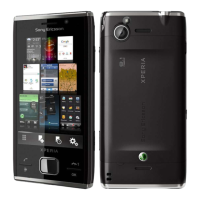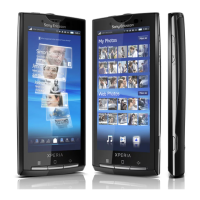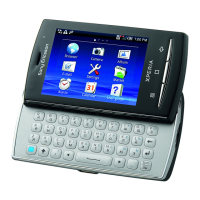Do you have a question about the Sony Ericsson Xperia Arc S and is the answer not in the manual?
Defines an application as a phone program that performs a specific task.
Instructions on how to assemble the phone by inserting SIM and memory cards.
Step-by-step guide on how to power on the mobile device.
Guide to configure basic phone functions and essential settings during initial setup.
Importance of a Google account for using apps like Gmail, Talk, Calendar, and Android Market.
Visual guide identifying all the keys, ports, and components of the phone.
Instructions on how to connect the phone to a power source for charging.
Methods for zooming in and out on web pages or photos using touch gestures.
Explanation of the light and proximity sensors and their functions.
Information on small applications that can be used directly on the Home screen.
How to adapt the Home screen's appearance using wallpapers and themes.
Procedures for launching, closing, and multitasking between applications.
How to access the Notification panel for more details on alerts and ongoing tasks.
Instructions for using the on-screen QWERTY keyboard for text input.
How to type characters, variants, and use case switching on the keyboard.
Guide to using the Phonepad for text input, including numbers and symbols.
How to adjust ringtone and media playback volumes using the phone's keys.
How to select and set custom ringtones for calls and notifications.
How to change the phone's display language and text input options.
Tips for optimizing battery life and understanding battery consumption.
Steps to format the memory card, erasing all data.
How to configure the phone for Internet access and sending messages.
Information and warnings about using data services while roaming internationally.
Steps to choose between different network modes like 2G or 3G.
How to make emergency calls, even without a SIM card.
Basic instructions for making, answering, and ending phone calls.
How to access voicemail messages by dialing the service number.
How to set up and manage conference calls with multiple participants.
How to restrict incoming or outgoing calls using call barring.
Methods for transferring existing contacts to the new phone.
Creating, editing, and synchronizing contacts to avoid duplicates.
How to modify existing contact information, like name or number.
Methods for sending contact information to others via various transfer methods.
Guide to sending and receiving SMS and MMS messages.
Adjusting notification tones and vibration for incoming messages.
Procedures for creating, sending, and receiving email messages.
Adding an email sender's contact details to the phonebook.
Steps to set up additional email accounts on the phone.
Guide to creating or signing into a Google account for synchronization.
Adding and using the Timescape widget on the Home screen for quick access.
Filtering events in Timescape by type, such as missed calls or messages.
Connecting Facebook or Twitter accounts within Timescape for status updates.
Steps to download free applications and games from the Android Market.
Understanding application permissions and granting access to phone features.
Steps to create a Qriocity™ account for buying or renting movies.
Instructions for managing your time schedule, including creating and viewing events.
Instructions for setting and managing alarms, including sound and vibration.
Turning off a previously set alarm.
Synchronizing your phone with Gmail™, Google Calendar™, and Google™ contacts.
Using Sony Ericsson Sync to store and manage contacts and calendar.
Accessing the Internet wirelessly using Wi-Fi® technology.
Connecting to secured local networks via VPN for remote access.
Adding new Wi-Fi networks by entering SSID and security details.
Steps to enable and use the phone as a media server for other devices.
Enabling USB tethering to share the phone's internet connection with a computer.
Turning the phone into a Wi-Fi hotspot to share its internet connection.
How to use the search and address bar to navigate websites.
Creating shortcuts for frequently visited web pages on the Home screen.
Searching for specific text content within a currently viewed web page.
Customizing browser behavior, including auto-fitting web pages.
Instructions for playing audio content, navigating libraries, and using player controls.
Using the volume keys to control playback volume for music.
Playing tracks from playlists or albums in a randomized order.
Steps to create custom music playlists from artists, albums, or tracks.
Launching the TrackID™ application to identify music.
How to navigate through available FM radio channels.
Visual guide to the camera interface, keys, and settings.
Instructions for taking photos using the camera key and screen controls.
Capturing photos automatically when a smile is detected.
Selecting and customizing various settings for the still camera.
Adjusting color balance to match different lighting conditions.
Using pre-programmed scene modes for optimal photo settings in various situations.
Setting a delay before taking a photo for self-portraits or group shots.
Instructions for recording videos using the camera key or screen controls.
Selecting scene modes like Portrait, Landscape, or Night mode for videos.
Selecting different video resolutions like HD 720p, VGA, or QVGA.
Accessing the Gallery app and browsing photos and videos by album.
Viewing Facebook photos directly within the Gallery application.
Performing batch operations on selected photos or videos within albums.
Editing photos by cropping them to a desired size or composition.
Instructions for playing, pausing, and sharing videos recorded on the phone.
Steps to pair the phone with other Bluetooth devices like handsfree or car kits.
Sharing files like photos, music, and contacts via Bluetooth.
Using USB cable to drag and drop files between phone and computer.
Explanation of MTP and MSC modes for USB data transfer.
Establishing a wireless connection between paired devices for file transfer.
Using the Media Go application for managing media content on phone and computer.
Steps to connect the phone to a TV via HDMI for screen mirroring.
Activating GPS satellite services for precise location tracking.
Explanation of how the GPS receiver calculates location using satellite signals.
Obtaining turn-by-turn directions for travel by foot, car, or public transport.
Protecting the SIM card with a PIN lock and managing PIN/PUK codes.
Creating a visual pattern lock for securing the phone screen.
Downloading and installing software updates via the Update center.
Updating phone software via a computer using a USB cable and PC Companion.
Using PC Companion to download and install phone software updates from a computer.
Managing wireless connections, Wi-Fi, and mobile network settings.
Configuring call management, voicemail, and call-related features.
Adjusting ringtones, vibration, alerts, and media volume.
Setting screen orientation, brightness, and idle timeout.
Managing navigation settings and phone security features like locks.
Enabling application synchronization and managing online accounts.
Icons indicating signal strength, battery status, connectivity, and mode.
Steps to open the Support application and find required help items.
Basic troubleshooting steps for phone malfunctions and performance issues.
How to reset the phone to original settings, with or without data deletion.
Explanations for common error messages like no network coverage or SIM card issues.
| Announced | 2011, August |
|---|---|
| Dimensions | 125 x 63 x 8.7 mm (4.92 x 2.48 x 0.34 in) |
| Weight | 117 g (4.13 oz) |
| SIM | Mini-SIM |
| Type | LED-backlit LCD, capacitive touchscreen, 16M colors |
| Resolution | 480 x 854 pixels, 16:9 ratio (~233 ppi density) |
| Protection | Scratch-resistant glass |
| Chipset | Qualcomm MSM8255 Snapdragon S2 |
| CPU | 1.4 GHz Scorpion |
| GPU | Adreno 205 |
| Card slot | microSD, up to 32 GB |
| Video | 720p@30fps |
| Selfie camera | No |
| Loudspeaker | Yes |
| 3.5mm jack | Yes |
| WLAN | Wi-Fi 802.11 b/g/n, DLNA, hotspot |
| GPS | Yes, with A-GPS |
| Radio | Stereo FM radio, RDS |
| USB | microUSB 2.0 |
| Sensors | Accelerometer, proximity, compass |
| Stand-by | Up to 460 h (2G) / Up to 460 h (3G) |
| Colors | Pure White, Midnight Blue, Misty Silver, Gloss Black, Sakura Pink |
| Status | Available |
| Size | 4.2 inches |
| Operating System | Android 2.3 (Gingerbread), upgradable to 4.0 (Ice Cream Sandwich) |
| Internal | 1 GB RAM |
| Main Camera | 8 MP |
| Features | Geo-tagging, touch focus, face detection |
| Bluetooth | 2.1, A2DP |
| Battery | 1500 mAh |











